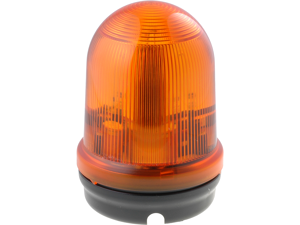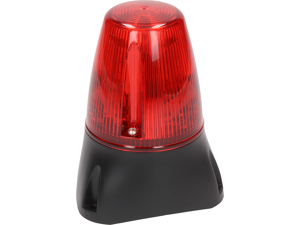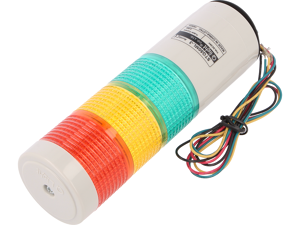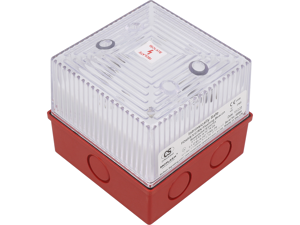The primary purpose of signalling devices is to convey unambiguous messages. However, in industrial (and other) settings there are numerous situations that require more complex solutions. So, which factors should be considered as the most important ones?
The answer to this question is simple: safety is always the key factor. Regardless of the context, the role of a signalling system is to inform operators and bystanders of specific hazards or conditions that require exercising particular caution.
Virtually every workplace, even an office, is fitted with a light and sound signalling system. We are often not aware of its presence, but it is, for example, an indispensable part of a fire alarm system. A fire alarm system uses lights and sirens, just like many other warning systems in factories, machinery parks and urban infrastructure elements. The same applies to anti-intrusion alarm systems. Therefore, see below for an overview of solutions and applications related to the broadly defined term “signalling”.
LEGAL REGULATIONS AND GOOD PRACTICES
Firstly, note that most regulations related to signalling systems in industrial applications and workplaces are enforced regionally, mostly within the framework of OHS regulations, fire safety standards etc. Therefore, guidelines provided by competent authorities must always be respected when installing such a system. For this reason, signalling devices supplied by global manufacturers can often be modified by the purchaser and adapted to local requirements (e.g. by changing the light colour, adjusting the volume and tone.
Now, let us list a few aspects that must also be taken into account when it comes to designing and installing signalling systems:
• Alerts must be well visible and audible, and, if possible, unambiguous.
• Each situation threatening human health or life must be signalled with an alert, similarly as in the case of indications displayed in hazardous zones.
• The signal intensity must take into account the environmental conditions and workplace characteristics. In areas where heavy machinery emits noise and workers are required to wear hearing protectors, the volume of alerts must be suitably adjusted. Similarly, visual signals alerting technicians who work in welding masks must also be adequately intensive.
• Transmitting a message is often related to a breakdown or emergency, so the power supply and control systems of signalling devices should be conditioned by but independent from the operation of the system/machine with which they work, and that applies especially to conveyors or production lines in factories and warehouses.
• Signalling systems should undergo regular inspections and maintenance.
• Regulations change frequently, buildings get renovated, and machinery is modernised, so it is worth considering signalling system scalability already at the design stage.
Each company should strive to develop uniform, clear rules and procedures for its labelling and signalling systems. Ideally, these should be intuitive or at least universal (like road signs and traffic lights). In practice, it is not always feasible. However, simplicity should always be one of the key assumptions. Its additional advantage is that it will also facilitate new personnel onboarding.
TYPES OF SIGNALLING DEVICES AND SPECIAL CASES
Signalling devices are generally divided into optical (light) and acoustic (sound) units, however, this division includes different subcategories defined by individual design solutions.
Technical aspects
First of all, it must be noted that there are several technical parameters to be taken into account, regardless of the signalling device type. These include electric parameters: power supply source (and voltage) and control method. Signalling devices can be activated as soon as power is applied, or require a separate signal to be provided. In other cases, (e.g. certain beacon towers), the device operation is controlled via pulses or digital protocols.
The degree of protection used is another important factor to be considered. Most products come with the IP65 or IP66 degree of protection, i.e. full dust-tightness and resistance to water splashes or even pressurised water jets (in practice, this means that a module can be washed with a high-pressure washer). Thermal tolerance is also important, in particular when products operate in extreme working conditions (e.g. in the metal processing industry or in cold stores).
Sound signalling devices
Sound signalling devices convey messages by emitting a sound with a specified tone and volume. These two parameters are directly related to components used in the device, e.g. a piezoelectric buzzer or speaker or even a ringer. As many products available on the market are based on electronic components, you may pre-set the signal intensity and type, which facilitates the unification of warning and alarm signals within the entire company.
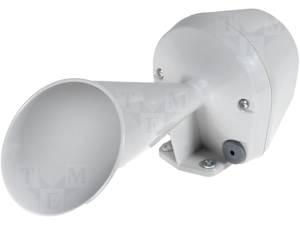
A typical sound level for most sound signalling devices is equal to or higher than 100 dB, which guarantees alert audibility, even in noisy production facilities. In extreme cases, signal intensity up to 120 dB is acceptable, but it must be borne in mind that a device emitting sound at this level must be placed in the optimum position (e.g. at a safe height), as emission of such a strong signal close to someone’s ear may result in hearing loss.
Voice messages
A voice signalling device is a relatively frequently used type of sound signalling devices, so it must definitely be mentioned in this article. This term is not entirely accurate, as, in practice, they are not necessarily designed to reproduce the human voice, although that is their most common purpose. They can be used to communicate more complex content, e.g. direct building occupants to proper escape exits during an evacuation process. A message is prepared in the form of a digital recording (MP3 file), placed in an emitter (usually on a memory card) and played back through speakers when triggered. To this end, some products are supplied with ready-made, professionally produced recordings.
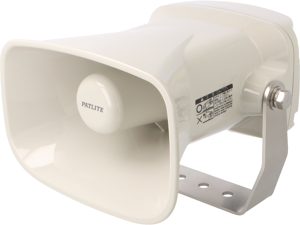
Light & light and sound signalling devices
Light signals are strictly codified by regulations specifying the intensity, colour and frequency of various messages, which applies in particular to alarms and warning lights (e.g. used in heavy machinery transported by roads). Rotating beacons are employed in industrial plants to alert users about, for example, machinery start-up, gate closing/opening, mechanism jamming, etc. They provide perfectly legible indications commonly used in transport, logistics, warehouses, etc. In the past, they were equipped with halogen or xenon lamps, but they are now being gradually replaced by more durable and almost equally bright semiconductors, i.e. LEDs.
Light and sound signalling devices are required or at least recommended for numerous reasons. Their “twofold” messages are more likely to be noticed by the audience, especially in suboptimal conditions, e.g. on a sunny day, a flash emitted by a lamp will be as muted as an alarm emitted by a buzzer against a background of heavy machinery noise. Therefore, lamps integrated with sound emitters are very popular types of signalling devices. Their components are the same as those described above, and they are available in various combinations, i.e. an intense sound signal does not necessarily have to be accompanied by a light signal of equally high intensity (e.g. in fire alarms, strong flashes might disorient the evacuees).
Signalling columns (beacon towers)
Beacon towers, i.e. a combination of several lamps and an optional speaker in the form of a small tower are a non-standard type of light or light and sound signalling devices. Such solutions are most often supplied as modular units, but compact versions are also available (with a conventional set of colour codes, i.e. green-yellow-red). Obviously, modular versions facilitate adjusting a signalling device to specific working environments, certain conventions or local regulations. It involves not only the light colours, but also the sound signal types (continuous, intermittent, pulse). Scalability is an important advantage of modular beacon towers, too.
Therefore, in some cases, where it is originally sufficient to install a single lamp, a modular solution is also worth considering. Beacon towers are usually installed with a base that also acts as a connector or distributor, and sometimes even on an additional foot with a sleeve to ensure its optimum height and visibility. They come in round (cylindrical) and wall-mounted versions (with a curved face for the widest possible emission radius).
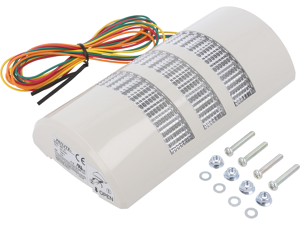
Explosion hazard zones
Explosion hazard zones (Ex) are probably the most unique operating environments for signalling devices, where volatile or liquid flammable substance leakage may occur (gasworks, petrochemical plants), or where hazardous materials are stored (e.g. munitions). In such spaces, both effective signalling and the necessity to use properly attested and certified products are equally important. It is quite obvious: if, on activation or during operation, a signalling device generates a spark, it may cause ignition. Therefore, solutions such as ringers or electromechanical components are out of the question. Moreover, signalling devices must be supplied via intrinsically-safe separators or Zener barriers (https://www.tme.com/br/en/katalog/measuring-conv-and-signal-isolators_113541/?params=377:1994072,1628795,1635691&productListOrderBy=1000028&productListOrderDir=DESC) fulfilling the same function. It is required by international regulations, such as the ATEX Directive implemented in the EU.


